Unlike many other breeds of poultry, moderns were developed specifically for exhibition. Moderns are a tall, refined breed, with what is almost an exaggerated length of neck and leg. The neck is to be long and slightly arched and the legs long and muscular. Although tall and refined, moderns are not to be lacking in body depth. A modern should have a short flat back, be wide at the shoulders, and narrow to the tail. A modern’s breast should be broad and full, not thin. When holding a modern, the breast should fill up your hand and the keel should not protrude out. Moderns should have a short whip tail. They should hold their wings up over the thigh but not over their back. The wings should not extend past the stern. The modern should be well-balanced, with its legs in the center of its body.
The goal of exhibiting, at least for me, is to try and produce that “perfect” exhibition specimen. Although this is a goal that is likely to be unachievable, I find the challenge of improving my flock of exhibition moderns over time to be very rewarding. I like seeing how my birds come closer to meeting the Standard of Perfection and the Bantam Standard with each generation. For those that may not be familiar with exhibition poultry, there is the American Poultry Association and the American Bantam Association. Each of these organizations produce a Standard by which exhibition poultry are judged. Each of these organizations has a program to train and license judges. Judges go by the Standard when judging exhibition poultry. Therefore, it is up to the exhibitor to develop a breeding program so that their birds meet the requirements listed in the Standard. How do you take your flock and breed them to more closely match the Standard? Well, there is not a single correct answer to this. Much of what winning exhibitors have learned has been through years of trial and error. My advice to anyone new to exhibition poultry is to first buy the Standard, either the Standard of Perfection, Bantam Standard, or both. Read your Standard and know your Standard. You can’t breed toward that “perfect” bird if you don’t know what the end goal is. The end goal is described in detail in the Standard. Additionally, you should buy the best birds you're able to afford from a reputable breeder that shows and does well in the shows. Talk to breeders. Find out what they do to improve on their flock over time. Finally, experiment with your breeding pens and keep good notes on your breeding program. Know what pair each chick comes from. If you’re going to improve your birds, you must know which combinations of breeding worked and which didn’t. Although you should buy the best birds you’re able to, this does not mean that you need to buy a “perfect” bird nor does it mean the birds that you buy won’t have areas in which they need improvements. What you are buying is genetics. Breeders that consistently win have been line breeding their birds for several generations. By getting breeding stock from them, you will have genetics that you can begin working with to produce show quality birds (Figures 1 & 2).
Comparing the birds in figures 1 & 2 gives an example of what can be done by line breeding. I purchased good stock, genetics, when purchasing my original modern breeders. The birds I purchased were not perfect, but they were from reputable breeders and gave me a good place to start.


Whether you’re breeding moderns or any other exhibition poultry, you should first begin by assessing what you have. How do your breeders line up with the Standard? What are their strengths? What are their weaknesses? Once you have these basics determined you need to decide what trait or traits you want to improve on first. To try and improve your birds in several areas simultaneously will likely result in frustration and disappointment. Once you’ve decided on one or a few traits that you want to improve on you should pair your birds so that they complement one another. If a bird is weak in a certain area, pair that bird with one that is strong in the area(s) that it is weak. It’s almost as though you are trying to build a better bird.
I’ll provide an example to better help you grasp the concept of pairing birds based on their strengths and weaknesses. My objective when I first began focusing my breeding program was to breed for taller birds. Looking at the competition at the shows it was clear to me that my moderns were a little shorter than much of the competition, especially the competition that was winning. Typically, with height comes back length in moderns, meaning taller birds tend to have longer backs. The Standard calls for moderns to have a rather short back. You want moderns that are wide at the shoulders with their back tapering to the tail (Figures 3 & 4). It would be relatively easy to produce taller birds by breeding large males to large females. To just breed your birds without consideration of other important traits, such as shape, width, and length of back, will result in birds that don’t meet the Standard. Instead of having short birds that lose in the shows, you’ll end up with tall birds that lose.


When selecting my breeders with the goal of producing taller birds with short, wide backs I used my tallest males that had wide backs. If a male was tall but did not have a wide back, I didn’t use him. I didn’t want to end up with tall birds that had narrow backs.
Season 1 – I selected tall males with short, wide backs. I mated these males to the best type females that complimented them. For example, if I had a male that carried his wings a little low, I mated him to a female that had good wing carriage or one that carried her wings a little too high.
Season 2 – Some of the offspring from the season one breeding (known as the F1 generation) were a little taller than their parents. I then used my tallest F1 males that also had relatively short backs and mated them to good type females that complimented them. I found that I didn’t necessarily need to mate these males to my tallest females. The idea is to mate them to the best type females that compliment them. I also learned that I can use a short male that has really nice type. Mating a short male to a tall female that compliments him can also give you tall birds with nice type. You will want to continue this mating strategy for as many generations as is necessary. Don’t go to extremes where you end up with birds that are too big. Also, consider other traits as you are doing this. Don’t sacrifice a good trait just to get taller birds.




This article previously appeared in the November 2021 issue of Exhibition Poultry Magazine.
If you would like to find out more about my breeding strategies that have worked well for me you can contact me to order a copy of my newly published book or find me at a show and ask questions. Since I’m a visual learner, I included lots of pictures (over 200 color pictures) comparing traits in my book.
This article was adapted from Jeff’s new book “Breeding and Showing Modern Game Bantams: Making it to Champion Row.” To order a copy of Jeff’s book email him at [email protected] or message him on Facebook.
The goal of exhibiting, at least for me, is to try and produce that “perfect” exhibition specimen. Although this is a goal that is likely to be unachievable, I find the challenge of improving my flock of exhibition moderns over time to be very rewarding. I like seeing how my birds come closer to meeting the Standard of Perfection and the Bantam Standard with each generation. For those that may not be familiar with exhibition poultry, there is the American Poultry Association and the American Bantam Association. Each of these organizations produce a Standard by which exhibition poultry are judged. Each of these organizations has a program to train and license judges. Judges go by the Standard when judging exhibition poultry. Therefore, it is up to the exhibitor to develop a breeding program so that their birds meet the requirements listed in the Standard. How do you take your flock and breed them to more closely match the Standard? Well, there is not a single correct answer to this. Much of what winning exhibitors have learned has been through years of trial and error. My advice to anyone new to exhibition poultry is to first buy the Standard, either the Standard of Perfection, Bantam Standard, or both. Read your Standard and know your Standard. You can’t breed toward that “perfect” bird if you don’t know what the end goal is. The end goal is described in detail in the Standard. Additionally, you should buy the best birds you're able to afford from a reputable breeder that shows and does well in the shows. Talk to breeders. Find out what they do to improve on their flock over time. Finally, experiment with your breeding pens and keep good notes on your breeding program. Know what pair each chick comes from. If you’re going to improve your birds, you must know which combinations of breeding worked and which didn’t. Although you should buy the best birds you’re able to, this does not mean that you need to buy a “perfect” bird nor does it mean the birds that you buy won’t have areas in which they need improvements. What you are buying is genetics. Breeders that consistently win have been line breeding their birds for several generations. By getting breeding stock from them, you will have genetics that you can begin working with to produce show quality birds (Figures 1 & 2).
Comparing the birds in figures 1 & 2 gives an example of what can be done by line breeding. I purchased good stock, genetics, when purchasing my original modern breeders. The birds I purchased were not perfect, but they were from reputable breeders and gave me a good place to start.
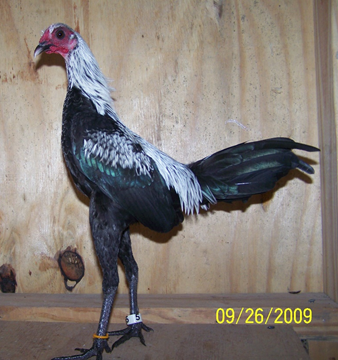
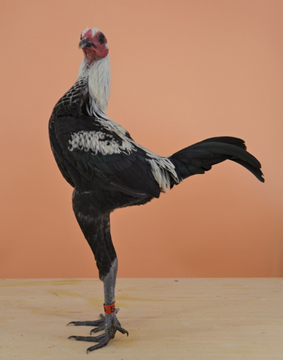
| Figure 1. This is a cockerel produced early on in my breeding program. Areas in need of improvement on this bird include: Wings are held a little too low; Wings are too long, they extend pasty the stern; Tail is too wide; Back is too long and narrow. | Figure 2. This is a cockerel produced several generations later in my breeding program. Although not perfect, it is far superior to the bird in Figure 1. This bird has very nice wing carriage, they are held correctly; Wings are the proper length; Tail is much more “whip” like; Back is short and wide. |
Whether you’re breeding moderns or any other exhibition poultry, you should first begin by assessing what you have. How do your breeders line up with the Standard? What are their strengths? What are their weaknesses? Once you have these basics determined you need to decide what trait or traits you want to improve on first. To try and improve your birds in several areas simultaneously will likely result in frustration and disappointment. Once you’ve decided on one or a few traits that you want to improve on you should pair your birds so that they complement one another. If a bird is weak in a certain area, pair that bird with one that is strong in the area(s) that it is weak. It’s almost as though you are trying to build a better bird.
I’ll provide an example to better help you grasp the concept of pairing birds based on their strengths and weaknesses. My objective when I first began focusing my breeding program was to breed for taller birds. Looking at the competition at the shows it was clear to me that my moderns were a little shorter than much of the competition, especially the competition that was winning. Typically, with height comes back length in moderns, meaning taller birds tend to have longer backs. The Standard calls for moderns to have a rather short back. You want moderns that are wide at the shoulders with their back tapering to the tail (Figures 3 & 4). It would be relatively easy to produce taller birds by breeding large males to large females. To just breed your birds without consideration of other important traits, such as shape, width, and length of back, will result in birds that don’t meet the Standard. Instead of having short birds that lose in the shows, you’ll end up with tall birds that lose.
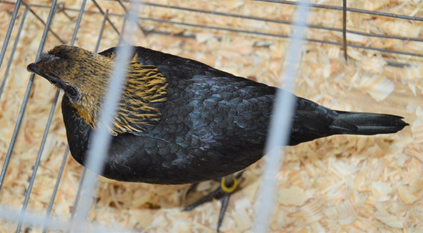
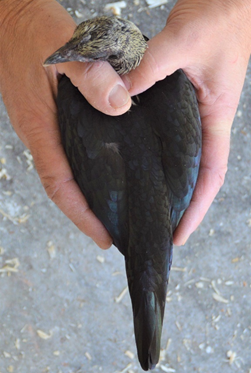
| Figure 3. The back on this brown red is too narrow, giving it somewhat of a tube shape appearance. | Figure 4. A modern should be wide at the shoulders and taper nicely to the tail, giving it a heart-shaped appearance. |
When selecting my breeders with the goal of producing taller birds with short, wide backs I used my tallest males that had wide backs. If a male was tall but did not have a wide back, I didn’t use him. I didn’t want to end up with tall birds that had narrow backs.
Season 1 – I selected tall males with short, wide backs. I mated these males to the best type females that complimented them. For example, if I had a male that carried his wings a little low, I mated him to a female that had good wing carriage or one that carried her wings a little too high.
Season 2 – Some of the offspring from the season one breeding (known as the F1 generation) were a little taller than their parents. I then used my tallest F1 males that also had relatively short backs and mated them to good type females that complimented them. I found that I didn’t necessarily need to mate these males to my tallest females. The idea is to mate them to the best type females that compliment them. I also learned that I can use a short male that has really nice type. Mating a short male to a tall female that compliments him can also give you tall birds with nice type. You will want to continue this mating strategy for as many generations as is necessary. Don’t go to extremes where you end up with birds that are too big. Also, consider other traits as you are doing this. Don’t sacrifice a good trait just to get taller birds.
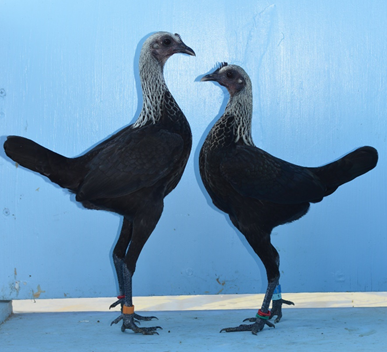
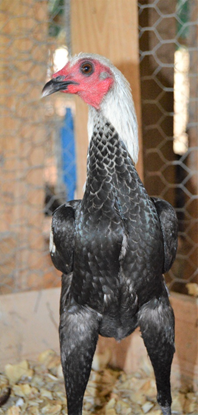
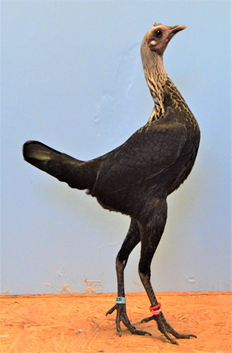
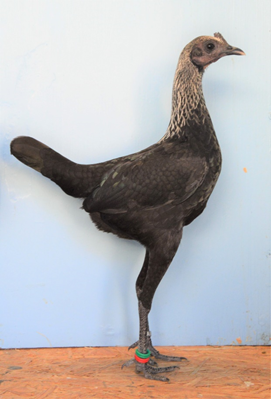
| It is possible to increase the height of your moderns without sacrificing overall type. | A good example of a modern with wide, prominent shoulders. | This birchen pullet was Grand Champion of the show at the Peach State Classic, GA. There were 1,028 birds in the show. | This birchen pullet was Reserve Show Champion at the Heart of Dixie Show, AL. There were 1,087 birds in the show. |
If you would like to find out more about my breeding strategies that have worked well for me you can contact me to order a copy of my newly published book or find me at a show and ask questions. Since I’m a visual learner, I included lots of pictures (over 200 color pictures) comparing traits in my book.
This article was adapted from Jeff’s new book “Breeding and Showing Modern Game Bantams: Making it to Champion Row.” To order a copy of Jeff’s book email him at [email protected] or message him on Facebook.
